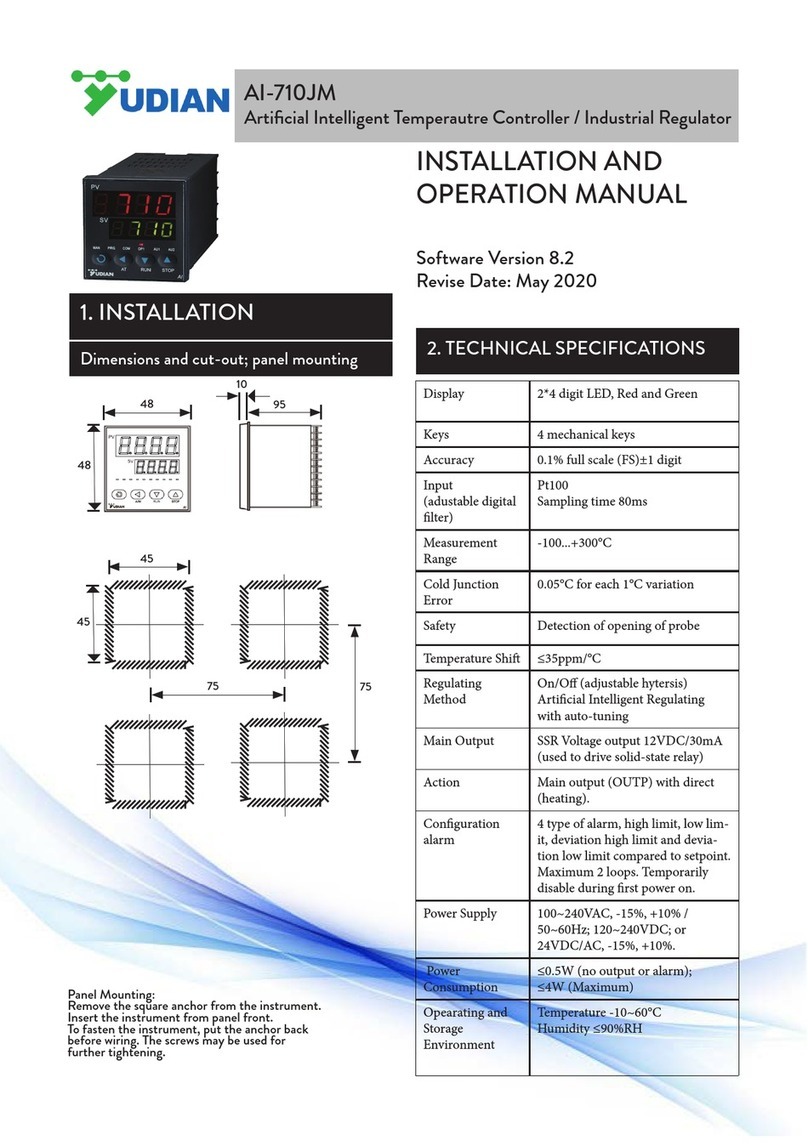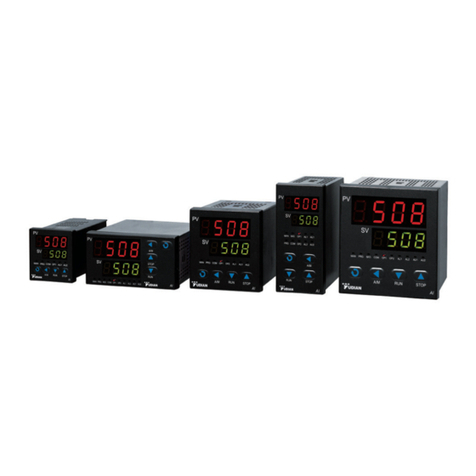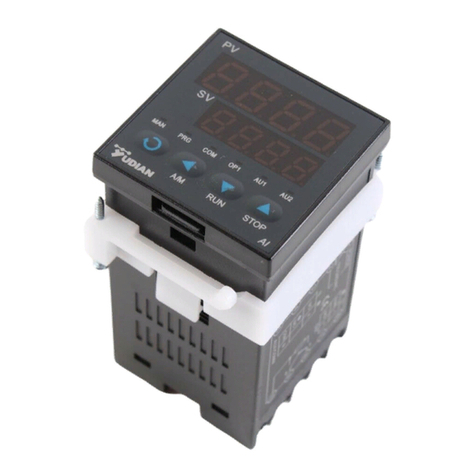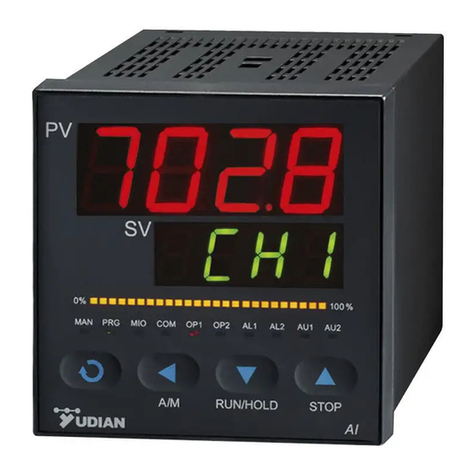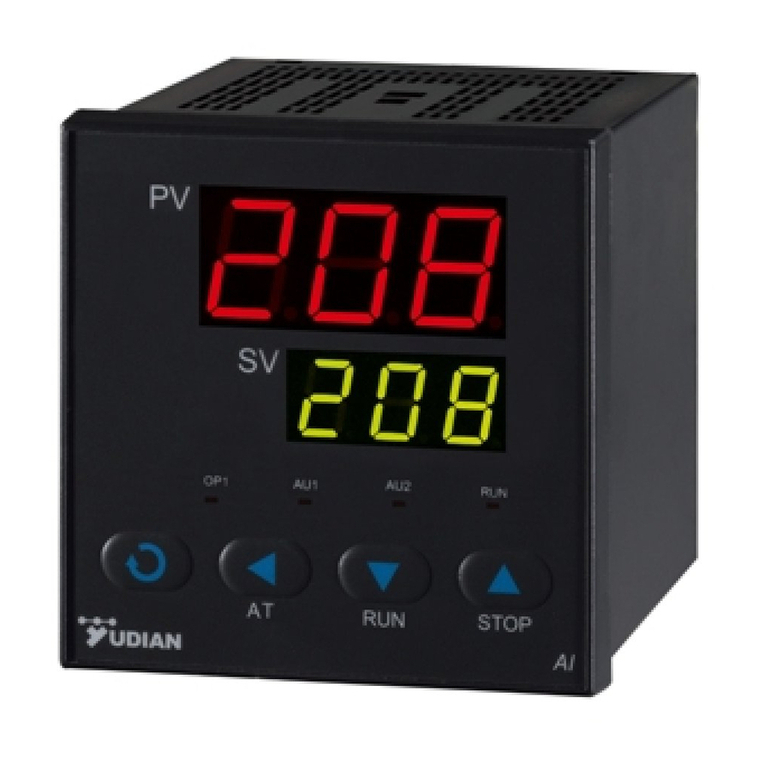
Yudian (H.K.) Automation Technology Co. Ltd.
Website: http://www.yudian.us http://www.yudian.com.hk
Email: sales@yudian.com.hk
Tel: +852-2770 8785 Fax: +852-2770 8796
III. FRONT PANEL AND OPERATION
①Process Value(PV), or parameter code
②Set Value(SV), alarming code, or value of a parameter
③Setup key, accessing parameter table, and confirming change.
④Data shift key, also for activating auto turning
⑤Data decrease key
⑥Data increase key
⑦Status display LED,
OP1 –Output
AU1 –Alarm 1
AU2 –Alarm 2
RUN –Controlling process running
Default display status:
When power is on, the process value (PV) and the set value (SV) are shown. lf the input signal is out of the measurable range (for example,
the thermocouple or RTD circuit is break or input specification is not correctly set), the upper display will blink “orA”and high limit or low
limit of specified input. The instrument will automatically stop the output.
IV. OPERATION DESCRIPTION
●Set Value Setting:
During default display status, if the parameter lock “Loc” isn't locked, user can set setpoint (SV) by pressing keys. Press
key to decrease the value, key to increase the value, and key to move to the dot to the desiired digit (acting as a pointer). Keep
pressing or will speed up value change. The range of setpoint is limited by parameter SPH with default range 0 to 400.
●Parameter Setting:
During default display status, press and hold for 2 seconds will access Field Parameter Table (See V. PARAMETER AND
SETTING). Press to proceed to the next parameter. If parameter table have not been locked, press will change the
parameter. Press and hold for 2 second returns to the preceding parameter. Press (don't release) and then press
simultaneously jumps out from parameter setting to the default status. The instrument will also jumps out auomatically from the
parameter table if no key is pressed in 30 seconds. Setting Loc=808 and then press will access System Parameter Table (See V.
PARAMETER AND SETTING)
●AI artificial intelligence control and auto tuning
When AI artificial intelligence control algorithm is selected (CrL=AI), the P,I, and D parameters can be calculated automatically by
auto-tuning. In default display status, press and hold for 2 seconds, “At” auto-tuning parameter will show. Press to change the
value of “At” from “oFF” to “on”, then press to activate the auto-tuning. During auto-tuning, the instrument runs on-off control for two
cycles. The instrument will calculate the optimal P, I and D control parameter values and returns to default display. If user want to
interrupt the auto tuning process, press and hold the for 2 seconds. Change “At” from “on” to “oFF” and press to confirm. The
auto-tuning process will be cancelled and new P, I and D values will be calculated.
Note 1: The P, I and D parameters obtained from auto-tuning are dependent to the set value. It is recommended to set a set value to an
often-used value or mean value to perform auto-tuning. For the ovens with good heat preservation, the set value can be set at
the highest applicable temperature. Depending on hardware setup, the auto-tuning may take from a few seconds to a few hours.
Note 2: Parameter Ctl (on-off differential, control hysteresis) has influence on the accuracy of auto-tuning. Generally, the smaller the
value of Ctl, the higher the precision of auto tuning. But Ctl parameter value should be large enough to prevent the instrument
from error action around set value due to the oscillation of input. Ctl is recommended to be 2.0.
Note 3: Self-learning function enables the instrument to control better and better after time.
SV
信
号
输
入,
I4模
块
可
支
持
0-2
0m
A及
4-2
0m
A输
入,
并
可
直
接
输
入2
线
制
变
送
器
(9
接
正,
7接
负
)。
注:
依
据
安
装






